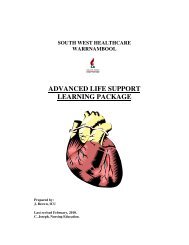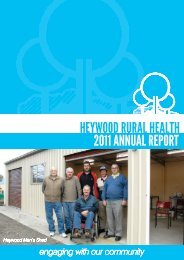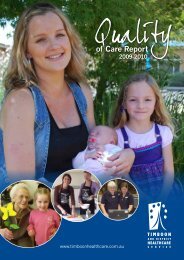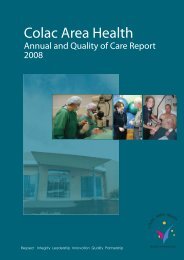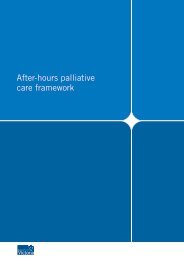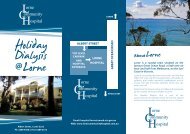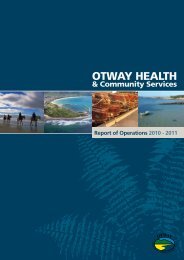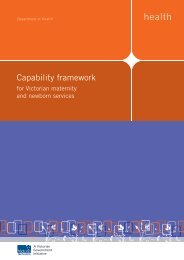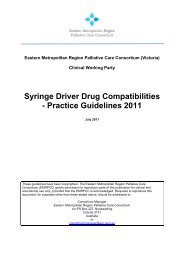Portland District Health Annual Report 2005 - South West Alliance of ...
Portland District Health Annual Report 2005 - South West Alliance of ...
Portland District Health Annual Report 2005 - South West Alliance of ...
- No tags were found...
Create successful ePaper yourself
Turn your PDF publications into a flip-book with our unique Google optimized e-Paper software.
Patient Education - MedicationsInvolving and educating patients about theirmedications prior to discharge reduces the risk <strong>of</strong>inadvertently taking the same medication, which mayhave two different brand names.‘At risk’ patients are identified using specific criteriaand referred for medication counselling with thepharmacist and pharmacy nurse.In the 5 months since the introduction <strong>of</strong> this positionpatients receiving discharge pharmacy lists has risenfrom 66% to 87% (Fig 2). This was achieved as adirect result <strong>of</strong> the nurses working with the pharmacistto improve this area <strong>of</strong> the service.120100806040200% <strong>of</strong> Medication Incidentswhich have MultidisciplinaryReview2004 <strong>2005</strong>Fig. 2Discharge Planning - MedicationsThe pharmacy nurses involvement with dischargeplanning has resulted in a smoother transition,particularly for patients returning to or enteringnursing homes or hostels. The nurse explores a range<strong>of</strong> issues using a checklist to assist the process. Issuescanvassed include management <strong>of</strong> medications, use <strong>of</strong>dosette or Webster pack, knowledge <strong>of</strong> medicationsbeing taken, reasons these are being taken andinstructions, over the counter medications, storagepractices, compliance with instructions, expiry datesand other issues.Falls PreventionFalls constitute the largest percentage <strong>of</strong> incidentsat <strong>Portland</strong> <strong>District</strong> <strong>Health</strong>, which is a similarsituation to most other organisations and is mainlydue to the ageing population. A greater awareness <strong>of</strong>falls prevention strategies, such as risk assessments,exercise, equipment and education help in reducingthe incidence <strong>of</strong> falls has been needed to deal withthis.At <strong>Portland</strong> <strong>District</strong> <strong>Health</strong> a Falls Prevention Programwas introduced in 2003 and over the past 12 monthsfurther enhancement <strong>of</strong> this program has occurred.There has been ongoing staff education combinedwith the use <strong>of</strong> falls prevention strategies, new fallsprevention equipment and upgraded risk assessmentprotocols. Increasingly there has a greater emphasison assessing people at risk <strong>of</strong> falling and puttingstrategies in place to reduce the incidence. This isevidenced by Fig. 3 which shows a marked increase incompletion <strong>of</strong> the assessment form between July 2004and June <strong>2005</strong>.120%100%80%60%40%20%0%Patient Handling Risk Assessment -Completion <strong>of</strong> MR158 on AdmissionJuly '04 Dec '04 June '05Fig. 3Pressure Ulcer Point Prevalence StudyAlong with other acute care hospitals <strong>Portland</strong><strong>District</strong> <strong>Health</strong> participated in the state-wide PressureUlcer Point Prevalence Study referred to as PUPPS. Itwas illustrated by the study in the previous year thatthe on going monitoring had paid dividends as wewere able to increase the level <strong>of</strong> scrutiny, thereforeidentifying 31% <strong>of</strong> patients on this day as having highrisk <strong>of</strong> pressure ulcers. Whilst we received a higherresult than the previous year we have identified areasfor improvement. The purchase <strong>of</strong> new mattressesfor all the acute beds will assist in the prevention<strong>of</strong> pressure points. Along with the survey a staffeducation program was conducted developing theability to assess patient risk <strong>of</strong> developing pressureareas, particularly if movement is limited due tosurgery or other condition.Regular wound management study days are conductedthroughout the year to improve skin and woundmanagement practice.Sharps incidentsAnalysis <strong>of</strong> sharps (Fig. 4) injuries to staff has revealedthat all <strong>of</strong> the injuries related to a failure in procedureas opposed to an equipment or storage issue. Thispresents us with a difficult challenge as every one <strong>of</strong>us are prone to making a slip up from time to time.Ideally we would like to devise systems that eliminateexposure to this risk or would separate staff from14



